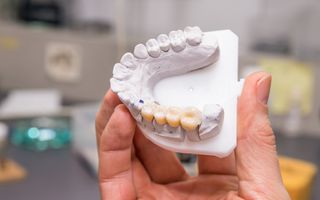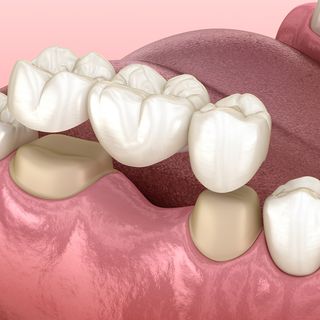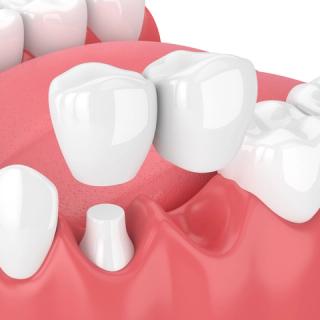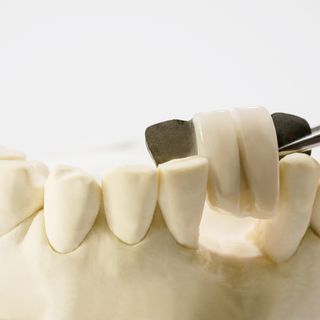
Dental Bridge
Bridging the gap with a bright, healthy smile.
A reliable solution for replacing missing teeth, dental bridges are a fantastic way to restore your smile and give you back the functionality of your natural teeth.
At Strathfieldsaye, our friendly and highly skilled team is here to guide you through the process, providing you with the best dental care in the relaxing environment of our state-of-the-art practice.
If you’re considering a dental bridge, here’s all you need to know about dental bridges at National Dental Care Strathfieldsaye.
What is a dental bridge?
A dental bridge is a fixed dental restoration used to replace one or more missing teeth by "bridging" the gap between two healthy teeth.
A typical bridge consists of two or more crowns, which are placed on the teeth on either side of the gap, and a false tooth (or teeth) in between, known as a pontic. These crowns, also called abutments, anchor the bridge securely in place.
Dental bridges can be made from a variety of materials, including porcelain, ceramic, gold, or a combination of these materials, ensuring a natural look and durable function.

What are dental bridges used for?
Dental bridges are primarily used to:
- Replace one or more missing teeth
- Restore the functionality of your mouth, including chewing and speaking
- Maintain the shape of your face by preventing the remaining teeth from shifting out of position
- Improve the appearance of your smile
- Provide support to the surrounding teeth and maintain their alignment
What are the benefits of dental bridges?
Dental bridges offer a range of benefits, including:
- Restored functionality: Bridges restore your ability to chew and speak properly, improving your overall quality of life.
- Enhanced appearance: A well-made bridge looks natural and can significantly improve the aesthetics of your smile.
- Prevent shifting: By filling the gap left by missing teeth, bridges prevent adjacent teeth from shifting out of position, which can lead to bite problems and other oral health issues.
- Maintain facial structure: Bridges help maintain the shape of your face, preventing a sunken appearance that can occur with tooth loss.
- Long-lasting solution: With proper care, dental bridges can last many years, providing a durable and reliable solution for missing teeth.
Types of dental bridges
Bridges are usually made from metal, porcelain, zirconia (a very hard substance), or a mix of any of the three, and there are three types of dental bridges:



What’s the process for getting a dental bridge?
The process of getting a dental bridge at National Dental Care Strathfieldsaye typically involves several steps and multiple visits. Proper oral hygiene and regular dental check-ups are essential to maintaining the longevity of your bridge.

1. Initial consultation
During your first visit, your dentist will conduct a thorough examination of your oral health, take X-rays, and discuss your treatment options. If a dental bridge is suitable for you, we will develop a personalised treatment plan.

2. Tooth preparation
The teeth on either side of the gap (called the abutment teeth) will be prepared by removing a portion of enamel to make room for the crowns. This step is crucial for ensuring a proper fit and strong support for the bridge.

3. Impressions
Once the abutment teeth are prepared, we’ll take impressions of your teeth. These impressions will be used to create a custom-made bridge that fits your mouth precisely. A temporary bridge may be placed to protect your teeth and gums while the permanent bridge is being made.

4. Bridge placement
When your permanent bridge is ready, you’ll need to come back for a second visit. The temporary bridge will be removed, and the new bridge will be fitted and adjusted to ensure a comfortable fit. The bridge will then be permanently cemented into place.
Results may vary in individual cases. The photo(s) used are stock photos of people who are not patients of National Dental Care, employees or affiliates.
Some other considerations for bridges when compared to other options for replacing teeth.
Some other considerations for bridges when compared to other options for replacing teeth.
Traditional bridges sometimes require putting crowns over perfectly healthy teeth: The adjacent teeth that support the bridge will require reshaping and covering, leading to the removal of a portion of their healthy tooth enamel. This heightens the potential for enduring harm to teeth that were initially in good condition. If the adjacent teeth already have fillings, crowns may benefit them.
Maryland bridges can cause damage to the existing teeth and are not as sturdy: Maryland bridges can cause permanent damage to healthy teeth due to the cementing of metal at the back of the teeth. Additionally, these bridges are less resistant to chewing pressure compared to other types of bridges.
Bridges don't correct bone loss in the jaw: When a tooth is absent or removed, the jaw bone that previously supported it initiates a process of resorption or dissolution. Unlike implants, which feature an artificial root anchored into the jaw bone, bridges are positioned above the gum line and lack roots. Consequently, bridges do not prevent bone loss like implants do.
Bridges may not last as long as implants: The success of the bridge depends on the health and strength of the teeth it’s placed on. If decay occurs under the bridge, if there are gum problems, the bridge can fail.

Why choose Strathfieldsaye for your dental bridge?
At National Dental Care Strathfieldsaye, we offer high-quality dental bridges that give you back your winning smile.
Make an appointment today
Restore your smile and enjoy the full functionality of your natural teeth, with dental bridge treatment at Strathfieldsaye.
Contact us today to schedule your consultation and start your journey to a dazzling smile.
Here are some reasons to choose us for your dental bridge needs
A friendly and experienced team: Our team of highly qualified dentists and support staff has extensive experience in providing quality dental care to the local community.
State-of-the-art facility: We use the latest technology and equipment to ensure you receive the best possible care.
Patient-centred approach: We focus on providing personalised care tailored to your individual needs, taking the time to listen to your concerns and answer your questions.
Comfortable environment: We understand that dental visits can be stressful. We’re here to make your experience as relaxing as possible within our welcoming practice.
Preventive approach: We focus on preventive care to help you maintain optimal oral health and avoid more serious dental issues in the future.
Affordable services: We want to make high-quality dental care accessible to everyone. Ask us about our convenient payment plans and health insurance partnerships.
Frequently asked questions
A dental bridge is a great way to replace a missing tooth for several reasons:
- Avoids an implant: Dental implants are affixed to the bone below the gum line, and some people prefer not to do this procedure. Also, implants are not suitable for those with poor gum or jaw health.
- A full smile and confidence: Missing teeth can lead to less confidence, with some people preferring to smile with their mouths closed to avoid showing the gap. A bridge fills this gap with a natural-looking tooth.
- Normal functionality: A dental bridge offers full functionality, meaning you’ll be able to eat, drink, and talk normally.
- Better oral health: A missing tooth can cause faster deterioration in your other teeth, and tooth movement for the remaining teeth, which means a bridge can improve your dental health.
You may need a dental bridge if you have:
- One or more missing teeth that affect your ability to chew or speak properly
- Healthy teeth on either side of the gap that can support the bridge
- A desire to maintain your facial structure and prevent teeth from shifting
- Good overall oral health, without severe gum disease or significant tooth decay
Not sure if a dental bridge is the right solution for you? Chat to our team and we can assess your oral health in order to recommend the best treatment option for your individual needs.
With good care and regular check-ups, a dental bridge can last for at least 10 years. You will need to avoid biting down on very hard and very sticky foods to minimise the chance of breaking the bridge or even pulling it off.
You will also need to maintain good dental hygiene to support the strength of your natural teeth and gums, as these support the bridge.
Usually, a bridge replaces just one tooth, but it can replace up to four teeth. It can depend on your oral health and the placement of the gap, so be sure to ask your dentist for the best options.
Dental bridges are quite safe with few side effects, but there are some possibilities to be aware of. These include swelling and pain around the site following each procedure, infection, potential nerve damage, and breakages or slips of the bridge itself.
If you experience any side effects following your dental bridge treatment, don’t hesitate to contact your dentist.
This cost varies depending on the type of bridge you get, the materials involved, and other factors. Your dentist will be able to give you a better estimate once they have a better idea of your situation and oral health.
Keep in mind, that your insurance may pay for some of the treatment, so it’s worth checking with your provider.
Ready to restore your smile? Regain functionality with a dental bridge and take the first step towards a restored smile. Get in touch with our friendly team to schedule an appointment.
The exact procedure of your dental bridge may vary depending on the condition of your teeth and gums, and the type of bridge you get.
Typically, however, your dentist will start by doing an examination and x-ray and treat any gum disease or tooth decay before starting. The site and two abutment teeth must be in good condition to support the bridge.
Next, your dentist will prepare the abutment teeth. The dentist will remove a thin layer of enamel from each one to make space for the crowns, then make impressions of those teeth to send away to a lab. This lab will create custom-made crowns and a false tooth for your smile.
To finish this appointment, your dentist will add a temporary bridge. This will protect your teeth and gums and help you eat and drink normally until your permanent bridge is ready.
During your next appointment, your dentist will remove the temporary bridge and affix the permanent one in place with a special dental cement. They will shape the tooth to suit your bite and ensure you are comfortable with it.



